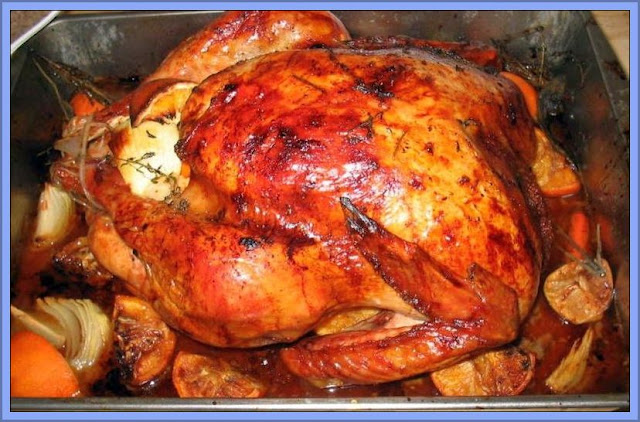 |
| British Traditional Christmas Fare |
So in medieval England, if you were wealthy enough to afford a special Christmas meal, it would likely to have been with wild boar (pig) as the meat centre piece. Later, in the 15th and 16th centuries this became goose or capon, and these were only slowly replaced as the most common meat by turkey.
Indeed, while the turkey started appearing on Christmas tables in England in the 16th century (the 16th century farmer Thomas Tusser noted that by 1573 turkeys were being fairly commonly served at English Christmas dinners), with popular legend stating that it was King Henry VIII who was the first English monarch to have turkey for Christmas, but it was still not the most popular Christmas meat.
But while the tradition of a turkey at Christmas was spreading throughout England by the 17th century, it also became very common to serve goose, which remained the predominant roast until the Victorian era. Indeed it may well be Charles Dickens who cooked the Gooses' goose (if you get my drift), when he wrote a A Christmas Carol in 1843. He cemented the idea of a 'Large Turkey' for Christmas, by having Scrooge send Bob Cratchett one on Christmas Day. However in truth, Turkey only really caught on for the masses when they were battery raised in the 1950's ....
Now I don't know about you, but I guess in my Anglo-Saxon way, I assumed that most of Europe (especially Western Europe), would be like us, Ireland, Canada, New Zealand, and Australia, and have roast turkey dinners .... but I was wrong.
- The US (who have turkey in Novembers Thanksgiving), will often have roast turkey (or other poultry), but beef, ham, or pork are all alternatives (only so much turkey you can eat in two months!!).
- Austrian households normally serve goose and ham for Christmas dinner.
- Czech Republic families serve a traditional Christmas meal of fried carp and potato salad.
- In Denmark, the traditional Christmas meal is served on December 24 and is normally duck or roast pork with crackling.
- In France, the Reveillon (or long meal), with include many course, but a traditional dish is turkey with chestnuts.
- Spain, often has a long evening meal as well, with no particular consensus on the meals content.
- The Dutch often have a long evening meal in the French style as well, but many will have meats and game like roast beef, duck, rabbit, and pheasant, and increasingly Turkey, which they seem to have picked up on from British TV, which most of the country pick up on.
- The Germans will often have roast goose and roast carp, as the primary Christmas dishes.
- Icelanders will use local produce or wildlife e.g. a kind of Gammon steak or roast game like reindeer, or ptarmigan.
- Italians vary greatly by region, and by north and south, with no national consensus on the meals contents.
- The Norwegians stick to the pork and crackling theme, with the most common dish being svineribbe (pork belly side prepared with seasoning such as salt and pepper), for proper crackling.
- Sweden has a number of courses which do include Swedish Meatballs! (I would have been disappointed if they hadn't!).
- While Poles practice a Catholic tradition of no mammal meat .... with stuffed carp, fried carp, herring in wine sauce, herring in cream sauce, offered instead.
- Portugal also sticks to the fish theme, with a traditional Christmas dinner on Christmas Eve eating boiled dried-salted codfish.
- Slovakians, also follows the fish path ... The traditional dinner includes carp or other fish.
 |
| Carp .... Maybe Not As Enticing As A Turkey. |
So it only remains for me to wish you a Merry Christmas in a couple of days time, and hope that you enjoy whatever your chosen main meal of choice is ...








What a feast of information!
ReplyDeleteI am just about to tuck into my own feast in around 15 minutes time ... traditional turkey and trimmings Mmmmm!! Happy Christmas Vroomfondel
Delete